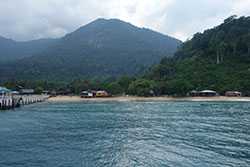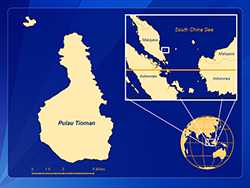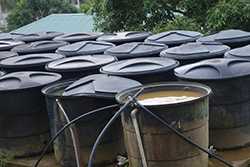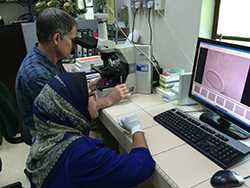GeoSentinel Uncovers Rare Disease

View of Tioman Island, Malaysia, when arriving by ferry. (Photo courtesy of Douglas Esposito)
Tioman Island is a short ferry ride away from the east coast of peninsular Malaysia in the South China Sea. Shaped like a giant sleeping dragon, the island has lush tropical forests, secluded beaches, and emerald waters teeming with vibrant aquatic species and coral reefs that attract diving enthusiasts and other summer travelers from around the world. In 2011, however, dozens of summer tourists returned home with something far less desirable than sandy shoes, spoiled sunset snapshots, and senseless souvenirs.
In October, two travel medicine specialists in Munich and Würzburg, Germany, treated a handful of patients with high fever, severe muscle pain, and abnormal levels of eosinophils, a specific kind of disease-fighting white blood cell. The abnormal white blood cells, combined with inflamed muscles and fever, indicated that the doctors were dealing with something unusual. However, another clue to the mysterious illness was that all of these patients recently traveled to Tioman Island.
A muscle biopsy identified their disease as muscular sarcocystosis, a parasitic infection rarely reported in humans. Upon diagnosis, the patients were immediately reported to the GeoSentinel Global Surveillance Network, which generated an inquiry across its membership to see if anyone else was finding similar symptoms in their patients.
Standing guard for disease threats in travelers
GeoSentinel is a worldwide communication and data collection network of travel and tropical medicine clinics, created in 1997 by a partnership between the Centers for Disease Control and Prevention (CDC)’s Division of Global Migration and Quarantine (DGMQ) and the International Society of Travel Medicine. Since its creation, the GeoSentinel network has steadily expanded from the initial nine U.S. sites to more than 60 travel and tropical medicine clinics in 29 countries on six continents. These sentinel clinics routinely and rapidly share patient observations and build the crucial science around geographic- and migration-based illness trends. This information helps CDC stay on top of changing disease risks, update pre-travel recommendations to keep people healthy during international trips, and provide medical evaluation advice for travelers who become ill.
Sarcocystis parasite moves beyond Malaysia
Sarcocystosis is a disease caused by a parasite called Sarcocystis. Two forms of the disease can occur: One form causes an intestinal infection and the second causes muscle pain, fevers, and other symptoms. The second form, muscular sarcocystosis, is spread through food, water, or soil that has been contaminated with feces from an infected animal. Muscular sarcocystosis occurs in tropical and subtropical regions, including countries in Southeast Asia. The disease is common among wild and domestic animals but is reported only rarely in humans.
The unusual illness and specific travel history of the patients diagnosed with muscular sarcocystosis struck a chord with other physicians in the network who also treated patients recently returned from holiday on Tioman Island with similar signs and symptoms.
Within days of the original reports, Douglas Esposito, MD, a DGMQ medical officer in the Travelers’ Health Branch, helped launch an international outbreak investigation, in collaboration with GeoSentinel. During the investigation, GeoSentinel and other physicians around the globe were notified to be on the lookout for patients with symptoms compatible with muscular sarcocystosis and a history of recent travel to Tioman Island. Data were collected and submitted to Esposito at CDC for analysis. Eventually, more than 30 patients suspected to be infected with the Sarcocystis parasite with travel during 2011 were identified from Germany, France, the Netherlands, Switzerland, Italy, and Canada.

Map of Tioman Island, Malaysia, in the South China Sea. (Map by Emily W. Lankau, DVM)
Communication with travel medicine specialists across the globe, in the patients’ home countries, was fundamental to initiating the Tioman Island investigation. Without the GeoSentinel network, it is possible the outbreak would never have been identified or investigated. During the investigation, the network also yielded unexpected benefits. “Because GeoSentinel got the word out, an affected but undiagnosed person struggling with muscle pain and fevers who was living in Singapore noticed the outbreak report in the journal EuroSurveillance during a Google search, and contacted me. Within one working day, the network arranged for a travel medicine specialist from Tan Tock Seng Hospital to evaluate the patient and make the diagnosis,” states Esposito. This example highlights the importance of global collaboration for sharing and broadcasting up-to-the-minute travel medicine information to help someone who might otherwise have gone undiagnosed and improperly treated.
After many months of careful monitoring with no new cases, 66 new patients were identified and reported to GeoSentinel in the summer of 2012. By the end of 2012, close to 100 suspected cases were identified, with nearly three-fourths meeting the case definition for muscular sarcocystosis. CDC and European public health authorities issued travel notices. Additionally, Ministry of Health Malaysia posted notices around the island reminding people to practice good handwashing and of the importance of careful food and water hygiene and avoiding contact with certain animals. Throughout 2013, the number of cases identified dropped significantly, causing investigators to breathe a temporary sigh of relief. Perhaps the outbreak had slipped away, quietly and as mysteriously as it arrived.

Water is captured during the rainy season and stored in these vats. (Photo courtesy of Douglas Esposito)
However, in 2014, while many of the world’s top disease detectives were busily managing the challenges of more notorious zoonotic disease outbreaks, like Middle East Respiratory Syndrome (MERS) in the Arabian Peninsula and Ebola in West Africa, a couple dozen more possible cases of sarcosystosis were identified as, yet again, coming from Tioman Island.
While the first two waves of infections were tied to travel to Tioman Island primarily during the summer months, the 2014 cluster of infections initially appeared to be occurring along with travel in early spring.
“There seems to be a seasonal trend related to the rainy and dry seasons. Depending on how rainy the rainy season gets may affect the timing of when we start seeing tourist infections,” says Esposito. Somehow, he explained, the tourists are getting infected, possibly through contaminated drinking water, by drinking while showering or brushing their teeth, or even swallowing water near the beaches. While Esposito is concerned about the unsanitary water supply on the island, the locals are not. “It isn’t the locals getting sick; it is only the tourists so far. This makes it hard to make a case for changing the way they collect and store their drinking water because it would be a significant economic burden for those living on the island.”

Predatory water monitors roam freely around the island's fresh water pools near a popular beach in one of the tourist villages. (Photo courtesy of Douglas Esposito)
Esposito and his fellow collaborators continue watching the situation and investigating when cases are reported. “There is definitely something unusual happening on Tioman Island with this insufficiently understood disease,” says Esposito. Water systems on the island were known to be deficient. Esposito continues, “Several patients who came back from their vacation on Tioman Island became sick for months and even years after contracting sarcosystosis. Because there is no treatment and the disease can be severe, we began investigating this outbreak for clues about how it is spread so we could interrupt transmission.”
While Esposito and the investigation team could not pinpoint the exact source of infection on the island, based on what was known about how the Sarcocystis parasite infects animals, they put cats, macaques, snakes, and water monitors, all plentiful on the island, high on the list of suspect hosts potentially causing the disease to spread to humans. The fact that transmission remains persistent and seems to come back on a seasonal basis yielded some important additional leads. Another important clue was the recovery of Sarcocystis nesbitti from two of the infected travelers to the island. Although the natural host of this specific organism is not yet known, knowledge of its genetics and the complicated lifecycle of Sarcocystis in general further implicates reptiles like snakes and, possibly, water monitors.
During a technical assistance visit to Tioman Island in 2014, Esposito and the investigation team honed in on the water monitor: a prolific, ravenous, and cannibalistic omnivore that enjoys free rein, leaving its droppings all about the villages, near the streams, and around the beaches. It is possible that this hypothesis could end up being a breakthrough discovery; however, at this point, Sarcocystis has been identified only in the muscle and not from the gut of some captured water monitors.
Increasing GeoSentinel’s capability and impact

Esposito and one of his Malaysian colleagues discover bradyzoites released from sarcocysts in processed muscle from water monitors captured on Tioman Island. (Photo courtesy of Douglas Esposito)
With U.S. residents making more than 60 million international trips in 2014, for everything from tourism, to business, to mission work, to visiting friends and relatives, Travelers’ Health staff must remain vigilant for health threats resulting from increased globalization. Gary Brunette, MD, DGMQ’s branch chief for Travelers’ Health, echoes these sentiments, “International travel is a part of our nation’s cultural, leisure, and business pursuits. We understand that, which is why we invest so much in the tools and networks we trust to aid us in preventing, detecting, and responding to disease threats around the globe. The GeoSentinel network is an important part of our arsenal for identifying and monitoring disease threats so we can continue preventing travel-imported cases of diseases like Ebola, MERS, dengue, and chikungunya in the United States. We know that uncommon tropical diseases, like sarcosystosis and these others, could be just a plane ride away.”
For Esposito, the Tioman Island outbreak investigation raises new possibilities. “Expanding the capabilities of GeoSentinel to include doing more collecting, testing, and banking of patient samples can assist us with better pinpointing the source of diseases, detecting where travelers acquire them, and sharing the most effective treatment options or therapies,” he says.
For more information about international travel health risks and recommendations, see:
- CDC Travelers’ Health Website (https://www.cdc.gov/travel)
- CDC Travel Health Alerts and Notices (https://www.cdc.gov/travel/notices/)
- CDC International Travel Health Information Reference Guide and “Can I Eat This?” Mobile Applications (https://www.cdc.gov/travel/page/apps-about)
- Mobile Applications (https://www.cdc.gov/travel/page/apps-about)
- Page last reviewed: December 23, 2016
- Page last updated: December 23, 2016
- Content source:


 ShareCompartir
ShareCompartir